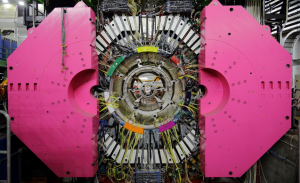 On January 19, 2024, the Cryogenic Facility Service group at LNF completed the final operations, which lasted over a month, to cool down to 4 Kelvin and reignite a superconducting magnet with a diameter of three meters and a length of over two meters. The magnet had been previously used as part of the detector for the FINUDA experiment, which recorded electron-positron collisions in the early 2000s produced by the DAFNE accelerator.
On January 19, 2024, the Cryogenic Facility Service group at LNF completed the final operations, which lasted over a month, to cool down to 4 Kelvin and reignite a superconducting magnet with a diameter of three meters and a length of over two meters. The magnet had been previously used as part of the detector for the FINUDA experiment, which recorded electron-positron collisions in the early 2000s produced by the DAFNE accelerator.
The magnet, a superconducting niobium-titanium solenoid built by Ansaldo Energia in Genoa in the 1990s, with an iron yoke mass of approximately 250 tons, has now been brought back to function after almost twenty years, generating a magnetic field of over 1 Tesla within a volume of about 15 cubic meters, powered by a current of 2700 amperes.
The entire process of refurbishing the various parts of the magnet and adapting the cryogenic system, which took over a year, required the involvement of specialized personnel from LNF.
The achieved result now allows for the proposal of the FLASH experiment (Finuda magnet for Light Axion SearcH), recently published by the COLD Lab group in the journal Physics of the Dark Universe. The project involves the incorporation of a cryogenic antenna inside the magnet to observe signals related to axions, hypothetical particles that could constitute the Dark Matter in our galaxy.
Reference:
1 – D. Alesini et al., “The future search for low-frequency axions and new physics with the FLASH resonant cavity experiment at Frascati National Laboratories,” Physics of the Dark Universe Volume 42, December 2023, 101370. https://www.sciencedirect.com/science/article/abs/pii/S2212686423002042
 INFN-LNF Laboratori Nazionali di Frascati
INFN-LNF Laboratori Nazionali di Frascati